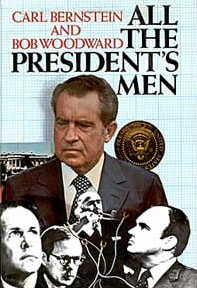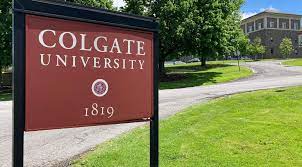|
The Context
Fall 1973, the New York Metropolitan region 50 years ago. Richard Nixon is an embattled President, with the Watergate Scandal gaining momentum. The World Trade Center had just officially opened in New York City that Spring and the Mets were making a run for the World Series. And, in a tiny village on the New York/Connecticut border, a new Junior/Senior High School was opening. Ordinarily, a new school opening would not necessarily be a significant event. But this school was unique in several ways. First and foremost, it was a school with no interior walls dividing classroom spaces. Second, the architecture was distinctly post-modern, predominantly glass-walled with deep-red brick. Upon first glance, one wouldn’t necessarily say, “Oh, that’s a school.” Set back from King Street – the road that divides New York from Connecticut – the school stood on a low rise to the right as you drove in. Set back from the driveway, the school had the air of a castle, with turret-like corners. To enter from the parking lot or front drive students, teachers, and parents would have to walk along a cobblestone “drawbridge” (about 50 feet long and 15 feet wide) to the set of glass doors at the entrance. Once through those doors you were in a foyer, bathed in natural light, with a public telephone mounted on the wall to your right and a suspended slat-through staircase to your left. Directly in front was a two-and-a-half story glass wall, with a huge, blue-carpeted open space on the other side. Entering “The Commons,” you were, once again, in a space you wouldn’t at all identify as a “Public School.” The long, wide space had low, padded wooden benches spread about, with another slat-through suspended staircase dividing the area – and an overhanging walkway above, to the left. Looking up, you saw angled skylights filling the room with natural light. At the end of The Commons was a descending staircase leading to a cafeteria, where the back wall, again, was glass. The sense of openness and light were the hallmarks of your entry into the building. An important opening “statement.” As you entered the “teaching areas,” walking in a semi-circle, you passed by “classrooms” that had no solid, interior walls or doors. Tall, rolling bookcases and movable wall dividers separated one “teaching area” from another. A visitor – or anyone, for that matter – could see what was going on in 6 to 8 classes in one spin around the area. Upstairs was the same, with the exception being the Science labs, which overlooked The Commons --- with glass walls. Their classes were visible to anyone standing on the suspended walkway above The Commons. The watchwords were openness and light. The other significant, distinguishing feature of the new Junior/Senior High School was the teaching staff. Because it was a new school in a small district (read, restricted budget due to low population) the first decade saw a procession of young, energetic, creative, and bright young educators learn to teach under the guidance of a visionary Principal. Finally, there was a clear philosophical emphasis on the Arts and Humanities, with an eye toward interdisciplinary education. Many of the new teachers had recently graduated from progressive teacher education programs, where the focus was on student-centered learning and critical thinking. As a result, Blind Brook Jr./Sr. High School, with its open concept, blazed a path unique in the history of public-school education, producing an impressive parade of exceptional graduates over its first decade --- as unique as the building itself. The Colgate Connection Colgate University rests in the sleepy little town of Hamilton, in upstate New York’s Chenango Valley. While notable alumni included Adam Clayton Powell and Charles Addams, Colgate’s claim to fame, for our purposes, has to do with its Teacher Preparation program from the late Sixties through the mid-1970’s. Under the supervision of William Griffith (Class of ’33) and the inspired leadership of Bill Moynihan (Colgate M.A.T., Syracuse Ed.D.) the program produced a small army of progressive educators, all with a mission to serve as “change agents” in the U.S. public school system. As synergy would have it, the creation of Blind Brook Jr./Sr. High School in September of 1973 proved to be the perfect landing field for Colgate Master of Arts in Teaching graduates. Throughout the late ‘60’s and early 1970’s Colgate’s Teacher Education Program focused on a humanistic, progressive approach to classroom teaching and learning. This meant reading Paolo Friere’s The Pedagogy of the Oppressed and Carl Rogers’s On Becoming a Person as well as Edwin (Ted) Fenton’s Teaching the New Social Studies in Secondary Schools: an Inductive Approach. Colgate’s program was aimed at producing educators intent on being teacher-leaders whose focus was student-centered and change-oriented. I’m not sure how much of that I was aware of when I applied to Colgate’s M.A.T. program in the fall of 1972 but when I was accepted and they offered not only a paid internship but also a substantial scholarship (combined with my Regents Scholarship, which was still usable 5 years after graduating from high school!) there was no question where I would prepare to become a public school teacher. Once I got there, in June of 1972, I learned two things very quickly: this was a serious and well-focused program, and I was with a cohort of equally smart and energetic future educators. On one of my first days there I met Steve Jones, a fellow Long Islander with a dedication to teaching and commitment to sarcastic humor that immediately made us fast friends. Colgate’s immersive summer program had us reading deeply, participating in probing seminars, and practice-teaching following a system developed at Stanford University called “micro-teaching.” Microteaching is a scaled-down, simulated teaching encounter designed for the training of both preservice or in-service teachers. It has been used worldwide since its invention at Stanford University in the late 1950s by Dwight W. Allen, Robert Bush, and Kim Romney. Its purpose is to provide teachers with the opportunity for the safe practice of an enlarged cluster of teaching skills while learning how to develop simple, single-concept lessons in any teaching subject. (https://education.stateuniversity.com/) Students from Hamilton High School were paid to be our classroom guinea pigs and we were videotaped and de-briefed every-other-day during the summer --- to work on our classroom practice skills. In all, the reading, the seminars, the microteaching, and the informal interaction with our cohort and professors proved a wildly effective preparation and, as it turned out, one that fit hand-in-glove with the new Blind Brook Jr./Sr. High School. As spring of 1973 unfolded, Steve Jones and I were living in a two-floor townhouse on the edge of the Colgate campus, rooting for the New York Knicks, and wondering if we would land jobs for the fall. It happened that I subscribed to the “Teacher Drop-Out Newsletter,” a publication out of Amherst, MA aimed at recruiting teachers for “alternative,” “open,” and “free” schools --- products of late 1960’s school reform notions of how schools should change. I was determined to find a job at a school that was on the cutting-edge of the reform movement. An ad for a new, “open-space” public high school opening on the New York/Connecticut border intrigued me. I had done my paid internship in the fall of 1972 at Greenwich High School – also on the NY/CT border – and had a wonderful experience. Greenwich was a huge public high school – around 2800 students, as I recall – divided into “Houses,” creating four smaller schools. Each House had its own teaching staff and administration, and the school used a “modified” block schedule, so classes only met 4 times week, with two meetings being 66 minutes (with the other two the usual 42 minutes) -- a great place for me to experiment with new ideas and methods. I answered the Drop-Out Newsletter ad and was invited to interview in the Village of Rye Town. I’m not sure everyone has a sense of how they fare in interviews, but I would say my sense of “oh, yeah” or “oh, no” has been almost flawless throughout my career --- whether interviewing for a teaching position or a bartending job. And the Blind Brook interview was no exception. The immediate rapport I felt when meeting David Schein, the new school’s Principal, proved true and my decade working with him bore that out. When I went to sign my contract, Dave Schein --- knowing he already had three Colgate M.A.T.’s in me, Steve Jones, and Roger Smith (sounding like a very WASPy law firm: Johnson, Jones, and Smith?) asked if there were any Science teachers in the Colgate program who might be interested in working at the new school. I told him I’d check and, before you knew it, Mike Nyhan (a married Army veteran from New Hampshire, who was in our M.A.T. cohort) was joining the staff, too. Out of 12 newly hired staff for the Blind Brook Jr./Sr. High School (“The Dirty Dozen,” according to Cora) four of us were products of Colgate’s progressive, change-agent program! Quite a coup. But that was just the tip of the Colgate iceberg. As it happened, I was hired by Colgate to serve as a “graduate student liaison” and “micro-teaching video de-briefer” for the summers of 1974, 1975, and 1976. I would be spending 6 weeks each summer, in Hamilton, with the cohorts that followed my group. Since Blind Brook had opened as a 7 through 10 school, it was hiring new staff until it graduated its first class in 1976. As a result, Dave Schein was looking for more progressive change-agents. Synergy. I became Dave’s talent scout and, in late-July/early August of ’74 & ’75 & '76 he would call and say: “We need a math teacher, another science teacher, and Spanish teacher.” I would pass the word along to candidates I had watched micro-teach (and gotten to know), encouraging them to apply to Blind Brook. Within the first decade of BBHS, ten of the high school’s 40 teachers were Colgate M.A.T.’s and we were making quite a mark on the school’s culture. Add to that group, our Assistant Principal Sal Corda’s work with Charles Weingartner (co-author of Teaching as a Subversive Activity) at NYU, the math department’s Jim Alloy and David Press with their experience in the New York City alternative Satellite Schools program, Bill Mendelsohn’s prep in a program at Yale, Doris Patrao’s experience at Sarah Lawrence and Columbia’s Teachers College, as well as the veteran teachers from Ridge Street – Jean Hurley, Jim Nelligan, Tommy Reistetter, Patty Overby and the Language Department (Simpson, Yellen, Toulouse) - who already had experience with Project-Based Learning and the Arts/Humanities Program --- and you had a very impressive staff primed to walk into a new building with no interior walls, glass walls, and a commitment to student-centered progressive education. We were off!
0 Comments
Leave a Reply. |
|
- Home
- The Blast -Blog
- The Blast (Archive)
- Blast Directory (Archive)
- California Streamin'
- Politics
- Culture
- ART
- SONGS
- Reviews
- Op-Ed Material
- New Writing
- Old Writing
- ARCHIVES
- "If you went to Yale . . ."
- Outing the Privilege Gap
- Thoughts on TFA
- Sir Ken Robinson: Education & Creativity
- My 91 seconds of Rock-music-video Fame!
- Creating Democratic Schools
- Acknowledgments
- About the Author
- Contact Info
Proudly powered by Weebly


